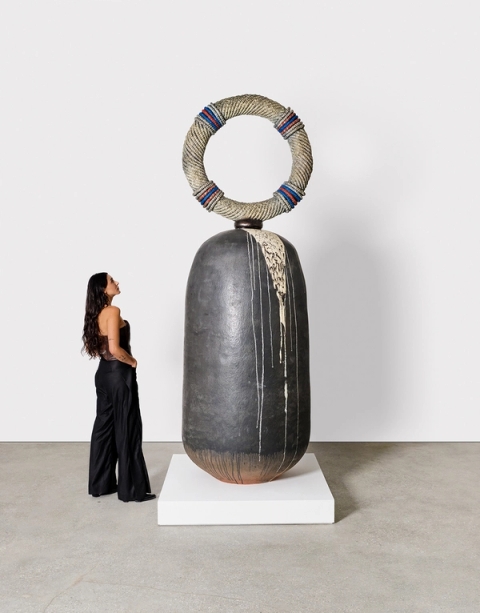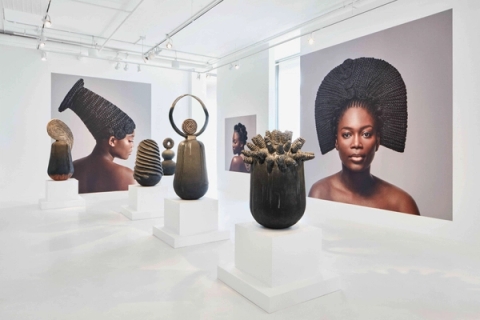My Enquiry (0)
No artwork has been selected.
Please choose an artwork to enquire.
Enquiry Submitted
Thank you for your enquiry and interest in our artists’ work. A member of the gallery team will respond shortly.
000%
22 February - 4 May 2024
Zizipho Poswa upscales objects of African beautification and ritual in this series of monumental sculptures. Precious metal jewellery, beadwork, hair combs and pins made by master artisans across the continent are emulated as bronze-cast elements resting atop vast ceramic silos, revering and immortalising the valued positions these amulets hold.
Indyebo yakwaNtu (Black Bounty) is Zizipho Poswa’s most ambitious technical undertaking to date, comprising five colossal ceramic and bronze sculptures reaching heights of over 8 feet tall. The clay bodies were produced during her summer-long residency at the Center for Contemporary Ceramics (CCC) at California State University Long Beach, where Poswa had access to the centre’s immense kilns.
She worked under the guidance of renowned American ceramic artist Tony Marsh, co-founder and inaugural director of the CCC, which functions as an influential hub for expanded discourse and advanced creative production in the West Coast ceramics community. Poswa joins the more than 200 artists from 20 countries who have been invited guests at the centre, including Magdalene Odundo, Simone Leigh, Akio Takamori, and Morten Løbner Espersen.
In this new body of work, Poswa consciously upscales objects of African beautification and ritual. Precious metal jewellery, beadwork, hair combs and pins made by master artisans across the continent are emulated as bronze-cast elements resting atop vast ceramic silos, revering and immortalising the valued positions these amulets hold.
Translated from Xhosa, “indyebo” literally refers to material riches but more broadly encompasses the cultural, economic, intellectual and spiritual wealth of Africans. “Ntu” is the spirit that defines and gives impetus – an embodiment of the identity, consciousness and life purposes of African beings. Indyebo yakwaNtu is, therefore, a fulfilment of Poswa’s ancestral mission to celebrate both the natural and self-producing beauty of the continent.
Her approach in this body of work is distinctly Pan-African: “Drawing on Africa’s own mineral wealth, her people have created an immeasurable creative collection from which African men and women adorn themselves, resulting in a language of objects that has come to shape our identity,” Poswa says.
With their bronze crowns, this series of sculptures stands as a praise song to early African civilisations. Poswa traces the traditional healing customs, polytheistic practices and cosmological knowledge of her amaXhosa culture to its Kemetic heritage. The influence of the Nubian kingdom – rich in gold, ivory and ebony – spread along the Nile from Eqypt to Sudan, South Sudan, Uganda and Ethiopia and through trade routes, human migration and nomadic cultures to the Swahili civilisation in Mozambique, the Sahara of Northern Africa, and the Southern African region where Poswa finds her home.
In Akan, a large square crest with filigreed pattern accentuates the beauty of the lapis lazuli- blue clay body beneath it. Modelled on a bead adornment worn by the Asantehemaa (the queen mother of the Asante people), this piece celebrates the authoritative positions women held in the Akan Kingdom’s dual-gender system of chieftaincy. Asante queen mothers commanded soldiers in war, engaged in politics, occupied chiefs’ stools, played senior advisory roles and resolved disputes in courts. (Stoeltje, B . J. 2021. “Asante Queen Mothers in Ghana”. Oxford Research Encyclopedia of African History.)
In another work, the Lobi people who settled in Burkina Faso are recalled through a majestic bronze reproduction of an ornate brass hairpin design. In a piece titled Fulani, the earrings traditionally worn by the Fulani women in West Africa, northern regions of Central Africa, South Sudan, Sudan, and near the Red Sea coast are emulated through sensuously enveloping swathes of bronze. Historically, these finely forged gold earrings served as a symbol of social standing, with their size indicating societal status or economic wealth.
Elsewhere, a “cisakulo” comb of the Chokwe from what is now Mozambique depicts an Ngungu bird, a symbol of strong leadership. Closer to home, Poswa references the Xhosa “isacholo” bracelet in an arc of four large spheres representing the white beads these are made of. This work “celebrates the heritage of the people who birthed me,” explains Poswa. Understood to hold healing properties, the isacholo is worn mainly by elderly Xhosa women as it is believed to alleviate blood circulation and bone-related ailments. In Xhosa culture, white beads symbolise purity, clarity and mediation. Today, they are still used as spiritual offerings worn by “amagqirha”, divine traditional healers, when communicating with the ancestors. In Poswa’s ceramic totem, beautification extends beyond the decorative to become a tool for spiritual resonance.

Often passed through generations of women as family heirlooms, jewelry’s importance surpasses its material value to encompass cultural, geographic, sentimental and matrilineal significance. Indyebo yakwaNtu extends Poswa’s artistic practice of homage to crowns worn by African women, which have previously included braided hairstyles and loads of water, firewood and produce carried on the heads of women across the rural Eastern Cape.
These monumental works revel in the transformative power of beauty – following on from Poswa’s acclaimed series Umthwalo (isiXhosa word for ‘load’), iLobola (customary dowry) and uBuhle boKhokho (Beauty of Our Ancestors) – honouring the community of women who raised her, while looking elsewhere to the continent for inspirational offerings.
“I am inspired by conscious design,” Poswa says, “Indyebo yakwaNtu is therefore an anthropological excavation that weaves together the socio-cultural and spiritual elements that underpin African creation.”
Artist
Works



Zizipho Poswa
Isacholo, 2024Bronze, glazed earthenware
116.13 x 42.13 x 39.75 in. | 295 x 107 x 101 cm

Zizipho Poswa
Cisakulo, 2024Bronze, glazed earthenware
107.88 x 43.25 x 36.63 in. | 274 x 110 x 93 cm

Zizipho Poswa
Fulani, 2024Bronze, glazed earthenware
96.88 x 48.38 x 26.38 in. | 246 x 123 x 67 cm
Sold








